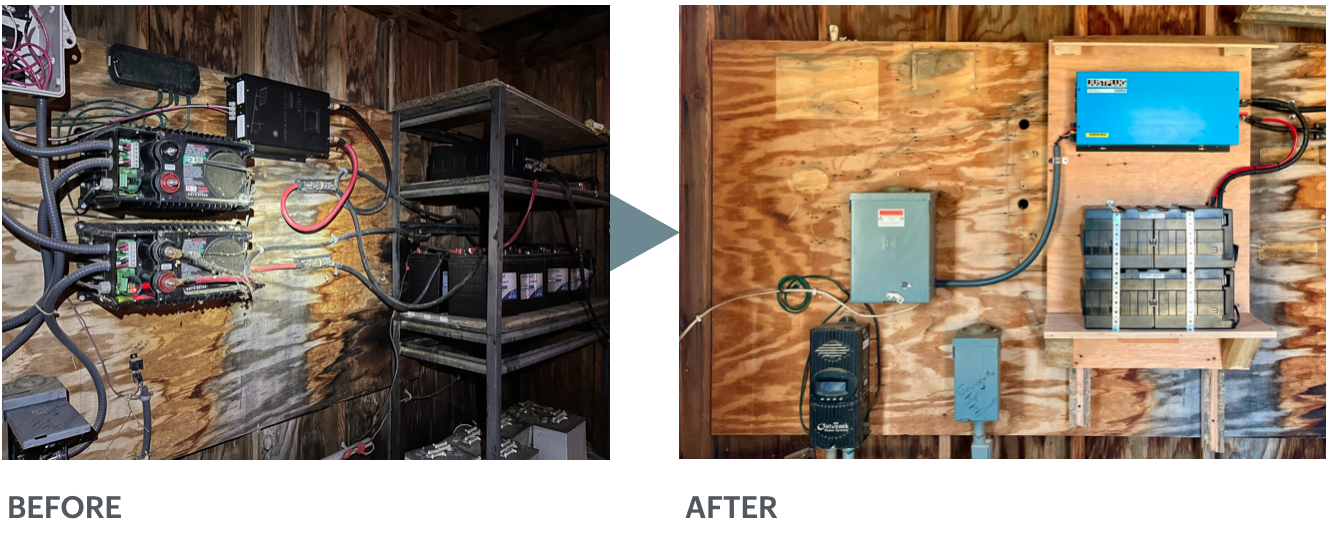Client Success Story: Modernizing a 15-Year-Old Solar System
Leslie’s 15-year-old solar power system has been deteriorating in performance. The lead-acid batteries stopped holding charges, and she contacted us to explore upgrading to lithium batteries. We evaluated her setup and proposed a couple of options.
Meanwhile, a rainstorm caused more damage to the existing inverters, and the system stopped working altogether. Leslie messaged us, and we were on site the next day with a spare inverter and a lithium battery module to troubleshoot the issue.
We hooked up the spare inverter and lithium battery provisionally, getting the system to produce and store power again — enabling Leslie to carry on with her day-to-day tasks. However, the temporary setup was not dimensioned to meet all her needs.
So, we returned the next day to assess her requirements. We had her turn on everything she wanted to run simultaneously to measure the power draw and determine the inverter capacity she needed. Then, we discussed the next steps.
We replaced two broken-down Outback inverters with a modern 5000W one and added maintenance-free lithium batteries to the lead-acid pack.
Leslie’s old system used two Outback inverters, configured to support a two-phase/240V system, even though Leslie only had 110V appliances. While the product is well-made, the equipment in Leslie’s shed had substantial wear and tear. We might be able to repair them, but the damage was extensive, and there’s no guarantee that the repaired equipment will last.
Additionally, these inverters consume more power than their modern counterparts. In this case, it would take about half of the lithium battery module’s storage capacity daily just to keep them on standby mode — a significant portion if you only have one or two battery modules!
For the cost of attempting a repair, we can provide a new, modern 5,000W single-phase pure sine wave inverter that doesn’t consume nearly as much power as the old ones. After weighing the cost vs. benefits, upgrading to a new inverter was the obvious route.
Next, we discussed the battery capacity Leslie needs. She has been very frugal with her power consumption because of the old system’s constrained storage capacity — so much so that she often forego using her small fridge. (The inverters’ poor condition might also limit peak power production.)
However, it doesn’t have to be that way. With two of our maintenance-free cold temperature-tolerant battery modules, Leslie can have ~3.56 kWh of additional storage capacity — allowing her to comfortably run Starlink, a fridge, phone and computer chargers, a microwave (not continuously, of course!) and more in the evening.
We also implemented our proprietary battery software to make the new lithium battery pack play nice with the old lead-acid ones. The lithium battery pack takes on most of the load (we program them to discharge before the lead-acid ones do), helping extend the lifespan of the lead-acid pack.
Many people enjoy the energy independence off-grid solar offers. They’re ready to make compromises, which might have been necessary 20 years ago when equipment was expensive. However, a lot has changed in the past decade. Solar panels are much cheaper, and battery technology has advanced by leaps and bounds (especially with our proprietary software!)
The total cost of ownership for a lithium battery solution is much lower than that of a lead-acid one — and we’re not counting the time-consuming maintenance required by a lead-acid pack! Additionally, the architecture of modern solar systems is more streamlined. With fewer components and (literally) moving parts, they’re more reliable and less likely to have issues.
Hit us up to see how we can help you refresh your existing solar system and remove the constraints of old technologies.


